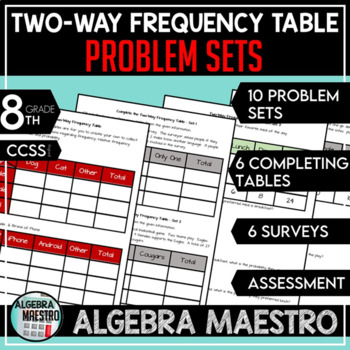Two-Way Frequency Table Problem Sets
- PDF
Description
The Two-Way Frequency Table (or two way tables) is designed to give students a lot of practice so they can fully understand and master two-way frequency tables. Included: 10 problem sets (40 total problems), 6 completing tables problem, 6 surveys to collect & analyze data, an assessment, and answer keys to every activity. These are great activities to get students to understand statistics and relationships including ratios, fractions, probability, and develop critical thinking and reasoning skills. You can use the problem sets in a variety of ways: relay race, scavenger hunt, whole group practice, small group practice, individual practice, etc. This topic is predominantly taught in Pre-Algebra, Algebra, Geometry, Algebra 2, and Statistics.
Table of Contents:
10 Problem Sets (pg 3 - 12)
6 Complete Table Problems (pg.13 - 15)
6 Surveys (pg 16 - 18)
Assessment/Test (pg 19 - 20)
Problem Set Answer Key (pg 21 – 31)
6 Complete Table Answer Key (pg 32 - 34)
Assessment Answer Key (pg 35-36)
Key words: two way frequency table, two way tables, frequency/frequencies, categorical variables, relative frequency/relative frequencies, conditional frequency, conditional relative frequency.
Please review if you purchase! Thank you!
You may also be interested in:





